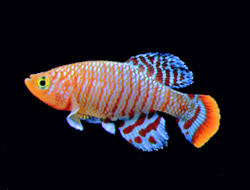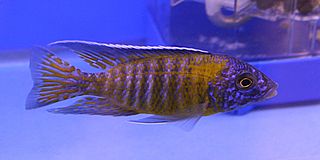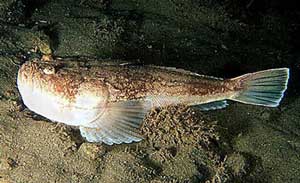| Leptolebias marmoratus | |
|---|---|
| Scientific classification | |
| Kingdom: | Animalia |
| Phylum: | Chordata |
| Class: | Actinopterygii |
| Order: | Cyprinodontiformes |
| Family: | Aplocheilidae |
| Genus: | Leptolebias G. S. Myers, 1952 |
| Species: | L. marmoratus |
| Binomial name | |
| Leptolebias marmoratus (Ladiges, 1934) | |
| Synonyms | |
Cynopoecilus marmoratusLadiges, 1934 | |
Leptolebias marmoratus, also known as the marbled pearlfish, is a species of killifish in the family Aplocheilidae. This threatened species is found in temporary channels within dense Atlantic rainforest, in the floodplains of rivers draining into the Baía de Guanabara, near the city of Rio de Janeiro in southeastern Brazil. [2] It reaches up to 3 cm (1.2 in) in total length. [3]
In biology, a species ( ) is the basic unit of classification and a taxonomic rank of an organism, as well as a unit of biodiversity. A species is often defined as the largest group of organisms in which any two individuals of the appropriate sexes or mating types can produce fertile offspring, typically by sexual reproduction. Other ways of defining species include their karyotype, DNA sequence, morphology, behaviour or ecological niche. In addition, paleontologists use the concept of the chronospecies since fossil reproduction cannot be examined. While these definitions may seem adequate, when looked at more closely they represent problematic species concepts. For example, the boundaries between closely related species become unclear with hybridisation, in a species complex of hundreds of similar microspecies, and in a ring species. Also, among organisms that reproduce only asexually, the concept of a reproductive species breaks down, and each clone is potentially a microspecies.

A killifish is any of various oviparous (egg-laying) cyprinodontiform fish. All together, there are some 1270 different species of killifish, the biggest family being Rivulidae, containing more than 320 species. Because of living in ephemeral waters, the eggs of most killifish can survive periods of partial dehydration. Many of the species rely on such a diapause, since the eggs would not survive more than a few weeks if entirely submerged in water. Like seeds, the eggs can be sent by mail without water. The adults of some species, such as Kryptolebias marmoratus, can additionally survive out of the water for several weeks. Most killies are small fish, from one to two inches, with the largest species growing to just under six inches (15 cm).
Family is one of the eight major hierarchical taxonomic ranks in Linnaean taxonomy; it is classified between order and genus. A family may be divided into subfamilies, which are intermediate ranks between the ranks of family and genus. The official family names are Latin in origin; however, popular names are often used: for example, walnut trees and hickory trees belong to the family Juglandaceae, but that family is commonly referred to as being the "walnut family".
This species is the only member of its genus, but several others were formerly included, making Leptolebias paraphyletic. To avoid this the other species have been moved to Leptopanchax , Mucurilebias and Notholebias . [2] [4] [5]
A genus is a taxonomic rank used in the biological classification of living and fossil organisms, as well as viruses, in biology. In the hierarchy of biological classification, genus comes above species and below family. In binomial nomenclature, the genus name forms the first part of the binomial species name for each species within the genus.
Leptopanchax is a genus of small fish, up to 5 cm (2.0 in) long, in the family Aplocheilidae. They are found in southeastern Brazil from Paraná to Rio de Janeiro. Depending on the exact species, they inhabit small seasonal channels in the Atlantic rainforest or temporary pools in open habitats.
Notholebias is a genus of fish in the family Aplocheilidae. These threatened annual killifish are endemic temporary waters, like ponds, in the Atlantic Forest in Rio de Janeiro state, Brazil.







